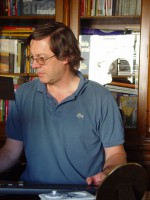resumo
This paper presents an alternative approach to estimate the parameters of the Benbow equation, widely used to define the contribution of parallel and convergent fluxes during the extrusion of ceramic bodies. The proposed method is based on a simplification of the equation that describes the difference of the extrusion pressure through dies with distinct lengths. This simplification, combined with an analytic change of the equation, allows obtaining two parameters from the experimental results, instead of using numerical fitting of reported values on the literature. The advantages of the proposed strategies are: (i) only three of the five parameters are numerically obtained, minimizing the risks of convergence to solutions mathematically corrected but without physical significance; and (ii) the relative deviations between Benbow's model and experimental results are lower when compared with those obtained when all parameters are numerically obtained. (C) 2014 Elsevier Ltd and Techna Group S.r.l. All rights reserved.
palavras-chave
TUBES; FLOW
categoria
Materials Science
autores
Vitorino, N; Ribeiro, MJ; Abrantes, JCC; Labrincha, JA; Frade, JR
nossos autores
Grupos
3 - materiais de carbono, compósitos e revestimentos funcionais
4 - biorrefinarias, materiais de origem biológica e reciclagem
Projectos
THERMICS- Cellular PCM-based composites with enhanced thermal conduction and shape stabilization (PTDC/CTM-ENE/2073/2012)
Centre for Research in Ceramics and Composite Materials - CICECO (LA0011: 2013-2014) (PEst-C/CTM/LA0011/2013)
agradecimentos
This work was supported by FCT, Portugal, and European funding (programs COMPETE, QREN and FEDER) under Projects Thermics PTDC/CTM-ENE/2073/2012, PEst-C/CTM/LA0011/2013, a PhD grant SFRH/BD/62598/2009, and also a PosDoc grant SFRH/BPD/99367/2013.





